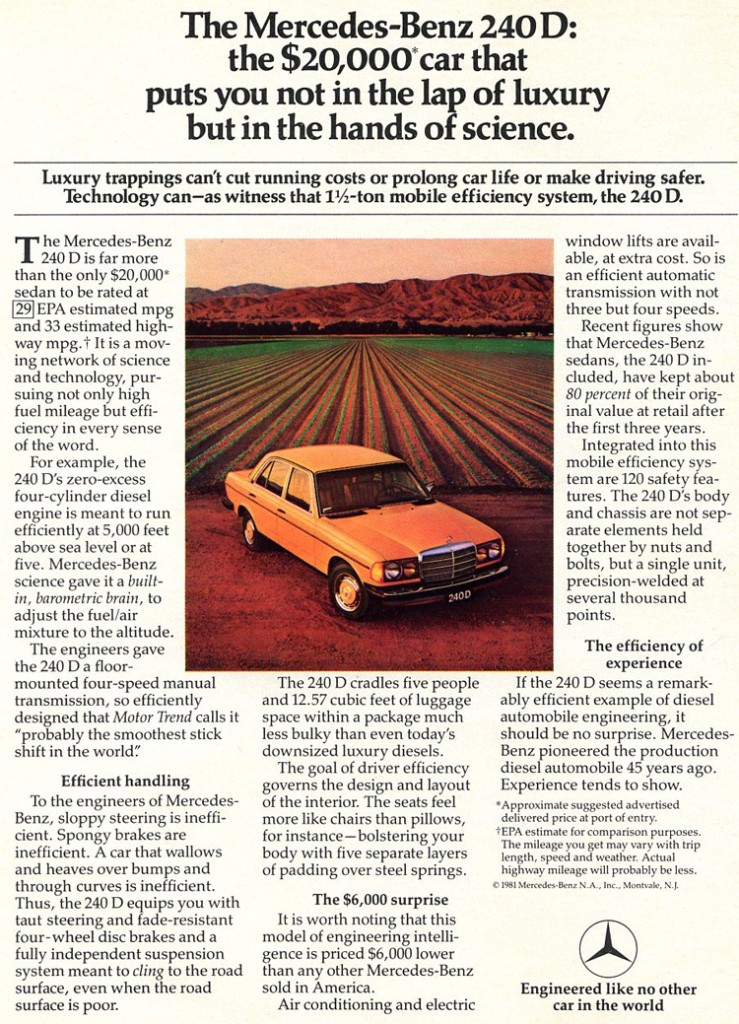
One of several advertisements I showed to my father at age twelve in 1980 attempting to sway his automotive purchase. We normally could not afford luxury cars, but a one-time windfall gave my father the option to that year. (Photo credit: Mercedes-Benz USA)
A friend recently asked me for advice on helping her select a new car. Since I’ve worked in the automotive repair field, I get requests for car purchasing advice periodically. I don’t mind because having been a car fanatic since birth, I’ve been giving family and friends advice my whole life on this subject no matter how solicited it was.
JAY LENO RECALLS “PERSUADING” HIS FATHER TO PURCHASE A 1966 FORD GALAXIE
This brought to mind a story car collector and comedian Jay Leno wrote about on his web site recently. Restoring a 1966 Ford Galaxie coupe similar to one his dad bought new when Jay was 16, he recalled pestering both parents into letting him choose the engine on the factory order sheet at their local Ford dealer in 1966. Figuring no difference would come of it, they said okay…and further ignored Jay’s off-sides conversation with the salesman.
“Here’s what we need. The 7.0-liter 428-cubic-inch V8. And (for even more power) the muffler delete package with straight glass-pack exhaust system,” Jay told him. Four weeks later when the car was delivered, his father was not happy. After being appalled with the loud noise coming from the glass-pack exhaust system (“A brand new car and there’s a hole in the muffler!”, he grouched) and doing an unintended burnout on the dealership’s cement driveway due to the high-torque engine, Mr. Leno was complaining about “the stupid car” all the way home.
Jay later came across a speeding ticket his father received in the Ford going 110 miles per hour. “So I know he really enjoyed the car”. Perhaps that engine proved too much for Jay, as he ended up crashing the Galaxie into a tree in 1973.
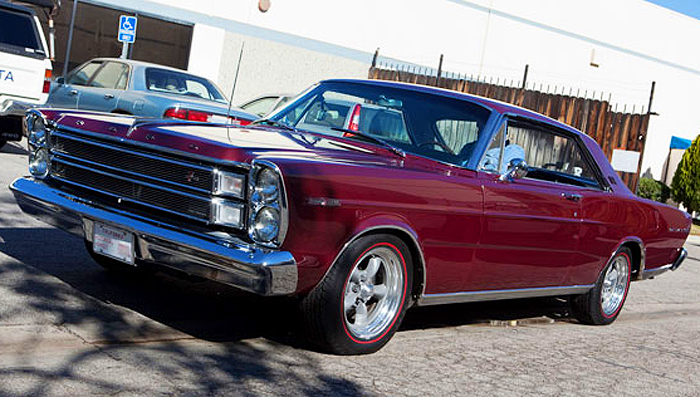
Jay Leno in his restored 1966 Ford Galaxie 7.0-liter, identical to one he helped “persuade” his father to buy new. (Photo credit: Jay Leno’s Garage)
(To see more of Jay’s commentary, see (http://www.jaylenosgarage.com/extras/articles/jay-leno-restores-his-childhood-favorite-the-ford-galaxie/).
Reflecting on Jay’s story was Road & Track columnist Peter Egan, who as a youth had no such luck getting his own father to listen to anything he recommended. Writes Egan, “My own father was quite vigilant any time I was around during the car-purchasing process. He knew instinctively that any car or drivetrain I might prefer was not in his best interest, or in the interests of society as a whole. When I tried to give my dad advice on which car to buy, his eyelids would droop into the half-closed position and he’d look at me with a kind of wary sadness, like a CIA bureau chief listening to the advice of a known Russian spy.”
(see http://www.roadandtrack.com/column/the-cars-of-the-parents-are-visited-upon-the-children)
GIVING CAR-BUYING ADVICE TO MY OWN FATHER AT AGE 12
Jay and Egan’s commentary was particularly amusing due to similar failures trying to sway my own father’s car preferences. Growing up, my parents typically preferred full-size American cars. Fords, Buicks, and Oldsmobiles equipped with vinyl padded roofs, whitewall tires, and wire-wheel hubcaps. Full-on luxury cars such as Lincolns and Cadillacs were not normally in our family budget.
In 1980, my father received an inheritance from his mother’s estate shortly after she passed. Ever prudent with money, my father responsibly planned to invest most of his sudden windfall in stocks and savings accounts. But he did decide it was also time to treat himself to a “nice” car since he’d been putting off replacing his worn-out one for some time.
At the worldly age of twelve, I had no shortage of advice for my father on the subject of what his next car needed to be. With the extra money he had this one time, he could finally reach into bona-fide luxury car territory. It was my firm opinion he should not blow this shot at getting something “nice”. What he needed was a car with real quality. One with bling and snob appeal. One that I fully approved of because I would, after all, have to get dropped off by him at Junior High each morning come September of that year.
I seized on the word “investment” I heard my father use often when lecturing me on the importance of properly saving for the future. “Dad, you need to make a smart investment with your next car. Buy a Mercedes 240D. It will last a long time”, and I handed him a Time magazine with the following two-page Mercedes-Benz advertisement extolling the virtues of the 240 Diesel. (Page 1 and 2 are below)
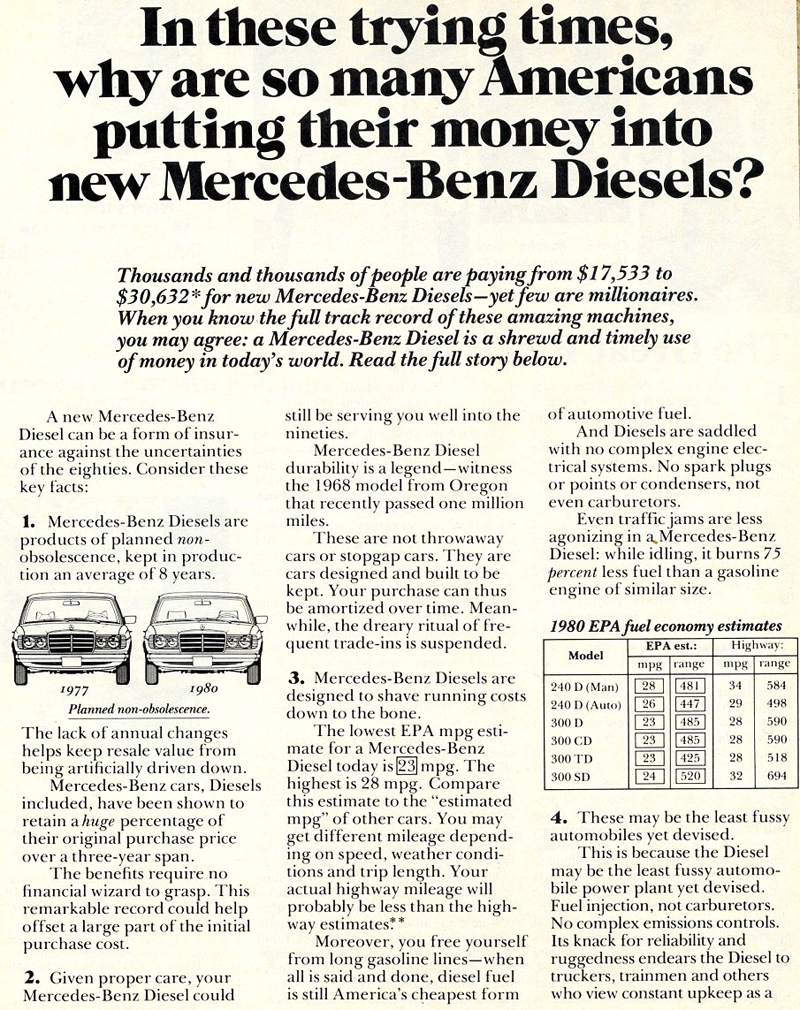
Page 1 of a 1980 240D advertisement I handed my father at the age of 12 attempting to sway his car buying decision. Page 2 is below. (Photo credit: Mercedes-Benz USA)
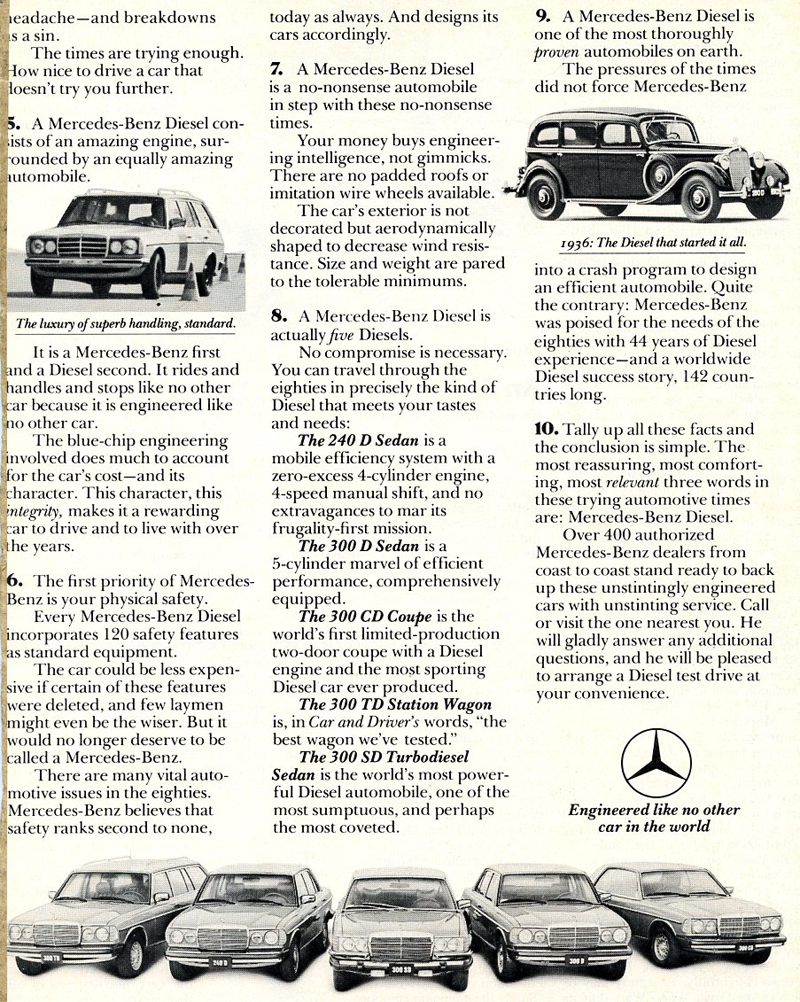
Page 2 of 1980 Mercedes 240D advertisement. (Photo credit: Mercedes-Benz USA)
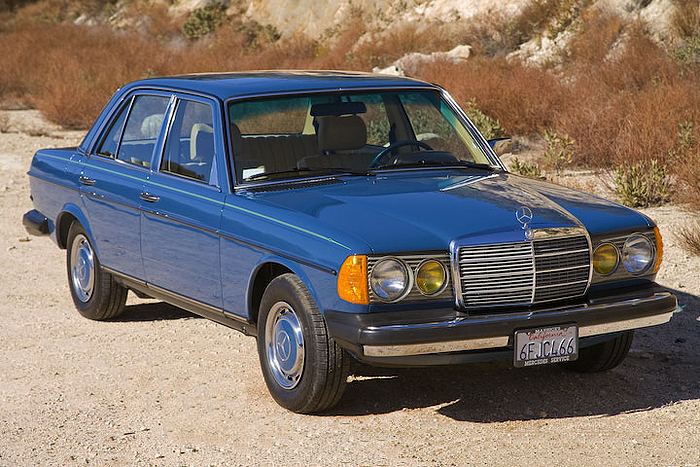
A better look at a 1980 Mercedes 240D. (Photo credit: Mercedes Motoring)
My father read the ad, nodded, made approving noises in his throat and thanked me. A few weeks went by and after careful consideration he instead chose a Chrysler Cordoba. The fire-sale prices Lee Iacocca was slapping on Chrysler division models during that year to stave off bankruptcy proved irresistible to my father, and the “Bill Blass Edition” two-tone paint with false convertible vinyl roof in the showroom proved irresistible to my mother. I was dismayed.
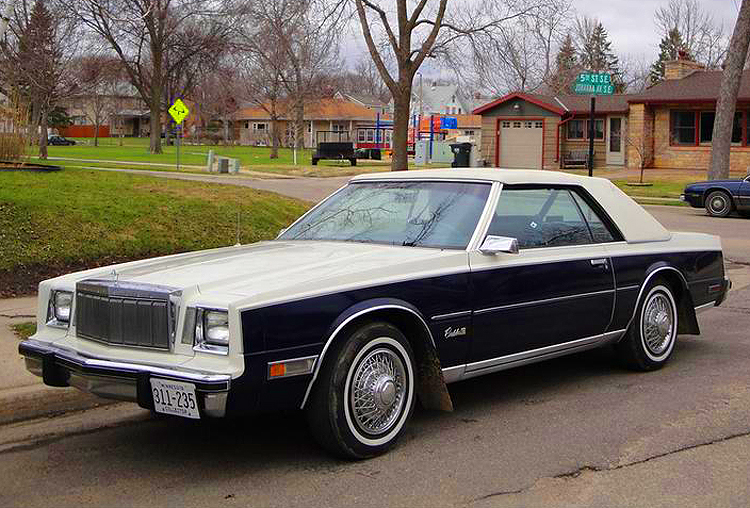
My father ignored my advice and bought a 1980 Chrysler Cordoba Bill Blass edition identical to this 1981 model shown. (Photo credit: “DVS1mn”)
Here was a supposed luxury car that came with cheap rear leaf springs instead of superior coil springs. A single headlight per side, instead of dual. And a three-speed automatic transmission when Ford LTDS, Olds 88s, Buick LeSabres, and even Toyotas began coming with four-speed overdrive units. On the bright side, the Cordoba did look moderately cool in an all-frosting, flashy way. People who didn’t know cars assumed it was more expensive than it was. And it had a V8 (thankfully not the base inline 6-cylinder which sounded at best like a clothes dryer when running).
PRESENT DAY
Back to the present and my friend (“Dawn” we’ll call her) shopping for a new car in the low $20,000 range. Since she asked for my judgement on what would be her smartest purchase, I vowed to focus on what Dawn needed and found important rather than what I preferred. I’d go along to road test whatever cars she was interested in and point out only what my trained senses picked up as fact. Biased opinions I would spare.
She subscribed fully to the philosophy that Japanese cars were better in every way and was leaning towards a 4-cylinder Nissan Altima or Honda Accord. Having rented both a Ford Fusion (heavily Mazda-based) and a Mazda 6 in the last year, I pointed out they were both four-door sedans in her price range – would she give them a try as well? I also expressed my fondness for Subarus because I feel they are products of a company controlled more by engineers, not accountants that only increase in strength the larger a car company becomes.
While being an extremely intelligent professional, Dawn sees automobiles merely as appliances to be judged on black-and-white Consumer Reports ratings the same way refrigerators might be. I shared my feelings that a lot more can be learned about a car simply by paying close attention to one’s senses during a test drive.
For example, the Mazda 6 we first drove had a noticeably harsh ride over pavement expansion joints and did not seem comparable with the one I had recently rented. Checking tire pressures showed all 4 tires were incredibly high and had not been properly lowered during dealer prep (during shipping on boats or trains, tires are inflated to higher pressures to prevent any swaying). Had we not noticed and corrected this, we would have walked away from the testdrive with the wrong impression of the car. Because the salesmen were all busy with a full showroom on the last day of the month, keys were handed to us in a hasty manner to a car that wasn’t fully prepped for testdriving. It even had a V6 when we asked for a 4-cylinder. After we lowered the tire pressures, the Mazda’s ride felt as smooth and well-damped as I’d remembered. But because Dawn was not impressed with the six-cylinder’s acceleration, she lost all interest in trying the base four-cylinder model.
Next on Dawn’s list was her favored-to-win choice, the Nissan Altima. Driving it, a buzziness felt in the steering wheel and seat of our pants at lower speeds was noticeable. Indicating the engine mounts in this particular vehicle or on all Altimas were inferior to comparable vehicles and not up to the task of fully absorbing engine vibration. Dawn didn’t seem as interested in this detail, so I simply put forth my experienced observation that any increased vibration and harshness through a vehicle’s frame tend to increase failure of electronic modules and components in the long run. I noted also that two features the Altima came equipped with standard (and could not be ordered without) have tended to be problematic to all manufacturers that use them.
First, proximity sensors that sense if the key is near the car allow doors to unlock without even pressing button on the remote keyfob, and allow the engine to start merely by pressing a “Start” button instead of inserting the key. Because key sensors are built into the doorhandles and mounted externally, they often fail a few short years and miles down the road due to corrosion. And when they do, they tend to short out and drain the car’s battery creating a non-mechanical repair that cannot be ignored or delayed, regardless of one’s given financial situation at the time.
Second, push button start systems tend to have complex components built in to the steering column that have also been problematic to many manufacturers so far – costly when replacement is needed. While Dawn seemed more interested in past reliability ratings, she came to realize they cannot reflect generous use of newer unproven technology. This said, I kept other personal opinions about the Altima to myself. She really liked the CVT (continously variable transmission) the Altima 4-cylinder came with. Dawn wanted to come back and drive the Nissan again after seeing the rest on the list.
The other main choice on Dawn’s list was a Honda Accord. The four-cylinder engine felt buzzy and unrefined also. Was this a Honda? I recall the company’s offerings from as far back as the early ’80s feeling smooth, expensive and fun to drive. Dawn agreed this felt neither, and she disliked the design of the center console a great deal. The Honda did not offer a CVT automatic transmission she appreciated while testing the Nissan, so the Accord was out.
The Ford Fusion had good acceleration and while steering was somewhat numb, it delivered a smooth, nicely dampened ride over uneven surfaces indicating a well-designed suspension system. On paper, it had been receiving excellent J.D. Power scores. However what neither of us could get past was the loud tick-tock sound the turn signals emitted. The chintziness of the noise, we agreed, cheapened the whole car and would be difficult to live with on a regular basis. The Focus came close, but was out.
Up to this point, Dawn had continuously ignored my recommendations that a base four-cylinder Subaru Legacy might be worth a look. She didn’t think the brand mainstream enough, but when I pointed out it came with a CVT transmission like the Nissan, she was willing to give one a try. I pointed out Subaru was the only company that designed all their engines with opposing-motion pistons identical to some Porsche and Ferrari models. (Such pistons are laid out flat on a horizontal plane rather than up-down, which allows engine weight to be lower to the ground for better handling, and better-balanced reciprocating parts for less vibration.) I also mentioned what a blessing the Subaru’s standard all-wheel-drive system (which the Accord, Nissan, and Mazda did not offer) can be in our Northeastern winters. We were both impressed with the Legacy’s ride quality and that road harshness was barely felt.
Dawn did her homework researching all the details I had mentioned and did a second roadtest of the Nissan and the Subaru. Ultimately she came to agree the Subaru was a superior car both on paper and on the road and bought the Legacy – the one Japanese car she had the least interest in initially. While the Subaru salesman did thank me for doing his job for him on the road test, I give him the final credit for making the sale. His line – “Most of our Subaru customers are engineers and professionals that can afford more expensive cars. But the rich appreciate a smart bargain too.”
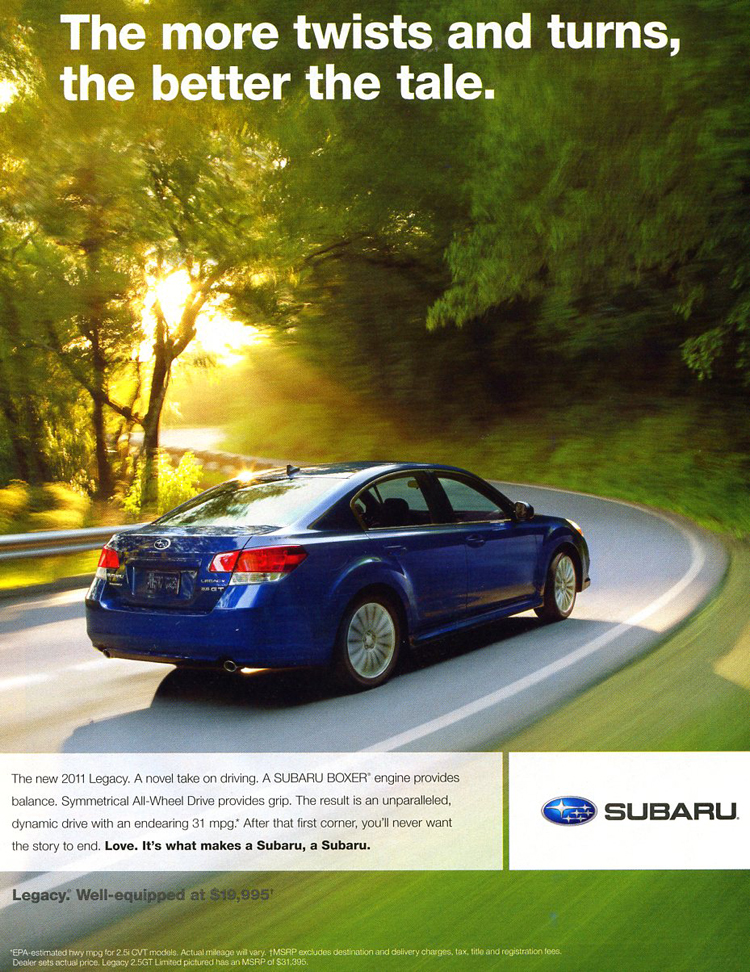
A friend asked me for car buying advice, and ended up purchasing a 2011 Subaru Legacy that had been at the bottom of her list initially. (Photo credit: Subaru of America)
 1969 Volkswagen Karmann Ghia wheelPhoto: Genna Rae
1969 Volkswagen Karmann Ghia wheelPhoto: Genna Rae 1969 Volkswagen Karmann GhiaPhoto: Genna Rae
1969 Volkswagen Karmann GhiaPhoto: Genna Rae 50s Calnevar aftermarket hubcaps shPhoto credit: T. Gorski
50s Calnevar aftermarket hubcaps shPhoto credit: T. Gorski Chrysler LeBaron Town & Country wheel cover
Chrysler LeBaron Town & Country wheel cover Cadillac Eldorado painted wheel cover 1976-78Photo: Nate Smith
Cadillac Eldorado painted wheel cover 1976-78Photo: Nate Smith 1974 - 1976 Lincoln Continental wheel coverPhoto credit: H. Carver
1974 - 1976 Lincoln Continental wheel coverPhoto credit: H. Carver 1969 Oldsmobile Cutlass Supreme rallye wheelPhoto: C. DeMarco
1969 Oldsmobile Cutlass Supreme rallye wheelPhoto: C. DeMarco Chrysler 1980s painted wheel coverPhoto: O. Stein
Chrysler 1980s painted wheel coverPhoto: O. Stein 13-inch General Motors color matched wheel 1975-80Photo: Valley Ride Styles
13-inch General Motors color matched wheel 1975-80Photo: Valley Ride Styles Audi TT RS wheelPhoto: Sean Connor
Audi TT RS wheelPhoto: Sean Connor 1994 - 1995 Mercedes E320 Cabriolet wheel
1994 - 1995 Mercedes E320 Cabriolet wheel 2012 Volkswagen Beetle 2.5 standard wheel
2012 Volkswagen Beetle 2.5 standard wheel 16-inch black steel Land Rover off-road wheelsPhoto credit: J. Getty
16-inch black steel Land Rover off-road wheelsPhoto credit: J. Getty 18-inch aluminum wheel on 2003 - 2004 Land Rover Discovery HSE
18-inch aluminum wheel on 2003 - 2004 Land Rover Discovery HSE 18 inch "Hurricane" aluminum wheel standard on 2002-2004 Discovery SE
18 inch "Hurricane" aluminum wheel standard on 2002-2004 Discovery SE 1957 - 1958 Pontiac wire wheel cover(Photo credit: R. Ulrich)
1957 - 1958 Pontiac wire wheel cover(Photo credit: R. Ulrich) 1972 Mercedes 280SE 4.5 equipped with repro 15-inch alloy wheels(Photo credit: Sean Connor)
1972 Mercedes 280SE 4.5 equipped with repro 15-inch alloy wheels(Photo credit: Sean Connor) 560SL 15-inch aluminum wheel
560SL 15-inch aluminum wheel 1981 Porsche 924 Carrera GT aluminum wheel
1981 Porsche 924 Carrera GT aluminum wheel 1978 Lincoln Mark V DJ blue wheel b(Photo credit: M. Garrett)
1978 Lincoln Mark V DJ blue wheel b(Photo credit: M. Garrett) 1979 Lincoln Mark V Collectors Series navy blue painted wheel(Photo credit: M. Garrett)
1979 Lincoln Mark V Collectors Series navy blue painted wheel(Photo credit: M. Garrett) 1969 Dodge Charger RT Hemi wheel with center hub cap
1969 Dodge Charger RT Hemi wheel with center hub cap 1953 Oldsmobile wire-wheel
1953 Oldsmobile wire-wheel 2014 Jaguar XK RS GT wheel at the 2013 New York Auto Show(Photo credit: Sean Connor)
2014 Jaguar XK RS GT wheel at the 2013 New York Auto Show(Photo credit: Sean Connor) 2014 Mercedes CLA45 AMG wheel at the 2013 New York Auto Show(Photo credit: Sean Connor)
2014 Mercedes CLA45 AMG wheel at the 2013 New York Auto Show(Photo credit: Sean Connor) 2013 Subaru WRX concept wheel at the 2013 New York Auto Show
2013 Subaru WRX concept wheel at the 2013 New York Auto Show 1952 Volkswagen wheelPhoto credit: L. Jacobs
1952 Volkswagen wheelPhoto credit: L. Jacobs 1975 Pontiac Grand Ville rallye wheelPhoto credit: Sean Connor
1975 Pontiac Grand Ville rallye wheelPhoto credit: Sean Connor 1991 Cadillac Fleetwood Brougham wire wheel cover
1991 Cadillac Fleetwood Brougham wire wheel cover Dodge Charger all-black police car wheel a
Dodge Charger all-black police car wheel a Dodge Charger all-black police car wheel b
Dodge Charger all-black police car wheel b 1963 Mercedes 230SL wheel at the 2013 June Jamboree in Montvale, NJPhoto: Sean Connor
1963 Mercedes 230SL wheel at the 2013 June Jamboree in Montvale, NJPhoto: Sean Connor 1964 Mercedes 230SL wheel at the 2013 Mercedes-Benz June JamboreePhoto: Kristi Burns
1964 Mercedes 230SL wheel at the 2013 Mercedes-Benz June JamboreePhoto: Kristi Burns
Commentary – Giving car buying advice to those you’re not sure are listening…
One of several advertisements I showed to my father at age twelve in 1980 attempting to sway his automotive purchase. We normally could not afford luxury cars, but a one-time windfall gave my father the option to that year. (Photo credit: Mercedes-Benz USA)
A friend recently asked me for advice on helping her select a new car. Since I’ve worked in the automotive repair field, I get requests for car purchasing advice periodically. I don’t mind because having been a car fanatic since birth, I’ve been giving family and friends advice my whole life on this subject no matter how solicited it was.
JAY LENO RECALLS “PERSUADING” HIS FATHER TO PURCHASE A 1966 FORD GALAXIE
This brought to mind a story car collector and comedian Jay Leno wrote about on his web site recently. Restoring a 1966 Ford Galaxie coupe similar to one his dad bought new when Jay was 16, he recalled pestering both parents into letting him choose the engine on the factory order sheet at their local Ford dealer in 1966. Figuring no difference would come of it, they said okay…and further ignored Jay’s off-sides conversation with the salesman.
“Here’s what we need. The 7.0-liter 428-cubic-inch V8. And (for even more power) the muffler delete package with straight glass-pack exhaust system,” Jay told him. Four weeks later when the car was delivered, his father was not happy. After being appalled with the loud noise coming from the glass-pack exhaust system (“A brand new car and there’s a hole in the muffler!”, he grouched) and doing an unintended burnout on the dealership’s cement driveway due to the high-torque engine, Mr. Leno was complaining about “the stupid car” all the way home.
Jay later came across a speeding ticket his father received in the Ford going 110 miles per hour. “So I know he really enjoyed the car”. Perhaps that engine proved too much for Jay, as he ended up crashing the Galaxie into a tree in 1973.
Jay Leno in his restored 1966 Ford Galaxie 7.0-liter, identical to one he helped “persuade” his father to buy new. (Photo credit: Jay Leno’s Garage)
(To see more of Jay’s commentary, see (http://www.jaylenosgarage.com/extras/articles/jay-leno-restores-his-childhood-favorite-the-ford-galaxie/).
Reflecting on Jay’s story was Road & Track columnist Peter Egan, who as a youth had no such luck getting his own father to listen to anything he recommended. Writes Egan, “My own father was quite vigilant any time I was around during the car-purchasing process. He knew instinctively that any car or drivetrain I might prefer was not in his best interest, or in the interests of society as a whole. When I tried to give my dad advice on which car to buy, his eyelids would droop into the half-closed position and he’d look at me with a kind of wary sadness, like a CIA bureau chief listening to the advice of a known Russian spy.”
(see http://www.roadandtrack.com/column/the-cars-of-the-parents-are-visited-upon-the-children)
GIVING CAR-BUYING ADVICE TO MY OWN FATHER AT AGE 12
Jay and Egan’s commentary was particularly amusing due to similar failures trying to sway my own father’s car preferences. Growing up, my parents typically preferred full-size American cars. Fords, Buicks, and Oldsmobiles equipped with vinyl padded roofs, whitewall tires, and wire-wheel hubcaps. Full-on luxury cars such as Lincolns and Cadillacs were not normally in our family budget.
In 1980, my father received an inheritance from his mother’s estate shortly after she passed. Ever prudent with money, my father responsibly planned to invest most of his sudden windfall in stocks and savings accounts. But he did decide it was also time to treat himself to a “nice” car since he’d been putting off replacing his worn-out one for some time.
At the worldly age of twelve, I had no shortage of advice for my father on the subject of what his next car needed to be. With the extra money he had this one time, he could finally reach into bona-fide luxury car territory. It was my firm opinion he should not blow this shot at getting something “nice”. What he needed was a car with real quality. One with bling and snob appeal. One that I fully approved of because I would, after all, have to get dropped off by him at Junior High each morning come September of that year.
I seized on the word “investment” I heard my father use often when lecturing me on the importance of properly saving for the future. “Dad, you need to make a smart investment with your next car. Buy a Mercedes 240D. It will last a long time”, and I handed him a Time magazine with the following two-page Mercedes-Benz advertisement extolling the virtues of the 240 Diesel. (Page 1 and 2 are below)
Page 1 of a 1980 240D advertisement I handed my father at the age of 12 attempting to sway his car buying decision. Page 2 is below. (Photo credit: Mercedes-Benz USA)
Page 2 of 1980 Mercedes 240D advertisement. (Photo credit: Mercedes-Benz USA)
A better look at a 1980 Mercedes 240D. (Photo credit: Mercedes Motoring)
My father read the ad, nodded, made approving noises in his throat and thanked me. A few weeks went by and after careful consideration he instead chose a Chrysler Cordoba. The fire-sale prices Lee Iacocca was slapping on Chrysler division models during that year to stave off bankruptcy proved irresistible to my father, and the “Bill Blass Edition” two-tone paint with false convertible vinyl roof in the showroom proved irresistible to my mother. I was dismayed.
My father ignored my advice and bought a 1980 Chrysler Cordoba Bill Blass edition identical to this 1981 model shown. (Photo credit: “DVS1mn”)
Here was a supposed luxury car that came with cheap rear leaf springs instead of superior coil springs. A single headlight per side, instead of dual. And a three-speed automatic transmission when Ford LTDS, Olds 88s, Buick LeSabres, and even Toyotas began coming with four-speed overdrive units. On the bright side, the Cordoba did look moderately cool in an all-frosting, flashy way. People who didn’t know cars assumed it was more expensive than it was. And it had a V8 (thankfully not the base inline 6-cylinder which sounded at best like a clothes dryer when running).
PRESENT DAY
Back to the present and my friend (“Dawn” we’ll call her) shopping for a new car in the low $20,000 range. Since she asked for my judgement on what would be her smartest purchase, I vowed to focus on what Dawn needed and found important rather than what I preferred. I’d go along to road test whatever cars she was interested in and point out only what my trained senses picked up as fact. Biased opinions I would spare.
She subscribed fully to the philosophy that Japanese cars were better in every way and was leaning towards a 4-cylinder Nissan Altima or Honda Accord. Having rented both a Ford Fusion (heavily Mazda-based) and a Mazda 6 in the last year, I pointed out they were both four-door sedans in her price range – would she give them a try as well? I also expressed my fondness for Subarus because I feel they are products of a company controlled more by engineers, not accountants that only increase in strength the larger a car company becomes.
While being an extremely intelligent professional, Dawn sees automobiles merely as appliances to be judged on black-and-white Consumer Reports ratings the same way refrigerators might be. I shared my feelings that a lot more can be learned about a car simply by paying close attention to one’s senses during a test drive.
For example, the Mazda 6 we first drove had a noticeably harsh ride over pavement expansion joints and did not seem comparable with the one I had recently rented. Checking tire pressures showed all 4 tires were incredibly high and had not been properly lowered during dealer prep (during shipping on boats or trains, tires are inflated to higher pressures to prevent any swaying). Had we not noticed and corrected this, we would have walked away from the testdrive with the wrong impression of the car. Because the salesmen were all busy with a full showroom on the last day of the month, keys were handed to us in a hasty manner to a car that wasn’t fully prepped for testdriving. It even had a V6 when we asked for a 4-cylinder. After we lowered the tire pressures, the Mazda’s ride felt as smooth and well-damped as I’d remembered. But because Dawn was not impressed with the six-cylinder’s acceleration, she lost all interest in trying the base four-cylinder model.
Next on Dawn’s list was her favored-to-win choice, the Nissan Altima. Driving it, a buzziness felt in the steering wheel and seat of our pants at lower speeds was noticeable. Indicating the engine mounts in this particular vehicle or on all Altimas were inferior to comparable vehicles and not up to the task of fully absorbing engine vibration. Dawn didn’t seem as interested in this detail, so I simply put forth my experienced observation that any increased vibration and harshness through a vehicle’s frame tend to increase failure of electronic modules and components in the long run. I noted also that two features the Altima came equipped with standard (and could not be ordered without) have tended to be problematic to all manufacturers that use them.
First, proximity sensors that sense if the key is near the car allow doors to unlock without even pressing button on the remote keyfob, and allow the engine to start merely by pressing a “Start” button instead of inserting the key. Because key sensors are built into the doorhandles and mounted externally, they often fail a few short years and miles down the road due to corrosion. And when they do, they tend to short out and drain the car’s battery creating a non-mechanical repair that cannot be ignored or delayed, regardless of one’s given financial situation at the time.
Second, push button start systems tend to have complex components built in to the steering column that have also been problematic to many manufacturers so far – costly when replacement is needed. While Dawn seemed more interested in past reliability ratings, she came to realize they cannot reflect generous use of newer unproven technology. This said, I kept other personal opinions about the Altima to myself. She really liked the CVT (continously variable transmission) the Altima 4-cylinder came with. Dawn wanted to come back and drive the Nissan again after seeing the rest on the list.
The other main choice on Dawn’s list was a Honda Accord. The four-cylinder engine felt buzzy and unrefined also. Was this a Honda? I recall the company’s offerings from as far back as the early ’80s feeling smooth, expensive and fun to drive. Dawn agreed this felt neither, and she disliked the design of the center console a great deal. The Honda did not offer a CVT automatic transmission she appreciated while testing the Nissan, so the Accord was out.
The Ford Fusion had good acceleration and while steering was somewhat numb, it delivered a smooth, nicely dampened ride over uneven surfaces indicating a well-designed suspension system. On paper, it had been receiving excellent J.D. Power scores. However what neither of us could get past was the loud tick-tock sound the turn signals emitted. The chintziness of the noise, we agreed, cheapened the whole car and would be difficult to live with on a regular basis. The Focus came close, but was out.
Up to this point, Dawn had continuously ignored my recommendations that a base four-cylinder Subaru Legacy might be worth a look. She didn’t think the brand mainstream enough, but when I pointed out it came with a CVT transmission like the Nissan, she was willing to give one a try. I pointed out Subaru was the only company that designed all their engines with opposing-motion pistons identical to some Porsche and Ferrari models. (Such pistons are laid out flat on a horizontal plane rather than up-down, which allows engine weight to be lower to the ground for better handling, and better-balanced reciprocating parts for less vibration.) I also mentioned what a blessing the Subaru’s standard all-wheel-drive system (which the Accord, Nissan, and Mazda did not offer) can be in our Northeastern winters. We were both impressed with the Legacy’s ride quality and that road harshness was barely felt.
Dawn did her homework researching all the details I had mentioned and did a second roadtest of the Nissan and the Subaru. Ultimately she came to agree the Subaru was a superior car both on paper and on the road and bought the Legacy – the one Japanese car she had the least interest in initially. While the Subaru salesman did thank me for doing his job for him on the road test, I give him the final credit for making the sale. His line – “Most of our Subaru customers are engineers and professionals that can afford more expensive cars. But the rich appreciate a smart bargain too.”
A friend asked me for car buying advice, and ended up purchasing a 2011 Subaru Legacy that had been at the bottom of her list initially. (Photo credit: Subaru of America)
About Sean
Welcome to Classic Cars Today Online! We seek to explore the subject of classic vehicles from the 1950s through today. It is our belief that a car needn't be old to be respected and admired for graceful design, historical significance, and future value. As founder and Editor-In-Chief, I welcome contributions from you about your own car-related interests and ownership experiences. As far as myself, I've worked in the automotive service field and have been a contributor to Autoweek Magazine, The Star, Mercedes Enthusiast Magazine, Examiner.com and more. Currently, I'm a copywriter and own several foreign and domestic classic cars. In my spare time, you'll find me serving as Technical Editor and officer of several car clubs, being a concours car show judge, and meeting some great folks around the tri-state NY / NJ / Pennsylvania area at car shows. - Sean Connor